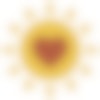All About Lighting
Home office lighting ideas abound. Whether you’re looking for a modern aesthetic or an old school vibe, you might find yourself drowning in lighting options. So here we are to bring you up for air, beginning with a simple principle: follow the sun.
The Purpose of Lighting
Our bodies are fine-tuned to flow with the rhythm of the day, sunrise to noon-sun to sunset to sleep. The most technical, the most elaborate and painstakingly researched office lighting systems are just trying to model what nature does with ease. We are organisms, adapted to the organic world, attempting to exist in our inorganic settings, and that takes effort.

Our first lighting recommendation is easy though. Find natural light, whenever and wherever you can. Step outside in the morning light, even if only for a minute or two. Place your desk near a window if possible. Build in breaks outside throughout the day, taking a moment to touch the sunlight before returning to your work.

"Natural light helps you connect with the seasons and time of day, helping you be more creative."
SARA SEGURA
Grovemade Maker
Why? Because the first purpose of lighting is health. As we learn more about circadian rhythms, we understand in a deep way how intimately we are tied to that ebb and flow of body activity. In 2017, three researchers received the Nobel Prize for discovering the inner workings of our daily clock. Our wellness depends on how well external cues match up with that internal clock. On the flip side, when they don’t match up, we feel it. Either in short term discomfort (“jet lag”), all the way to chronic health problems (anxiety, depression and more).
Circadian-rhythm research is rapidly expanding. And research into circadian-friendly lighting is keeping pace. Companies are spending money and time in an all-in effort to create energy-efficient, human-centered lighting systems, incorporating natural light, fluorescent lights, LED lights, adjustable and adaptive light technology, task lighting and indirect light sources into their work environments.


They’re trying to achieve another purpose of lighting, related to the first: reduce energy use (in both people and systems) and reduce strain. Since we’re also trying to be successful in our work, the third purpose of lighting: optimize your productivity and elevate your game. This includes setting the right mood, creating a space for conference calls, illuminating specific areas with focused light (task lighting).
Health, energy, productivity...what are we missing? Feeling! The fourth purpose of lighting is to make a space feel and look good, viscerally, intuitively, immediately.
Health, energy, productivity...what are we missing? Feeling! The fourth purpose of lighting is to make a space feel and look good, viscerally, intuitively, immediately.
The Four Purposes of Lighting
Health • Energy • Productivity • Feeling & Seeing
If you’re able to dive deep on lighting, Luma-Lighting style, for your home office, go for it! But if you would just like basic principles to go by, with some elegant lighting options laid out in front of you, we gathered some guideposts for you here.
The Colors of Light
The “color” of light is the color temperature of light, measured in Kelvin and calibrated to the color produced when metal is heated to a specific temperature. When searching for light bulbs, you might see the term CCT, which is the Correlated Color Temperature. The lower the CCT number, the warmer the light. The higher the number, the cooler the light. Per the color temperature page on Wikipedia, horizon daylight is around 5,000 K, vertical daylight around 6,500 K, and “clear blue poleward sky” is anywhere from 15,000 to 27,000 K.
Residential light bulb options usually fall into a tighter range, some as low as 1,900 K and as high as 10,000 K. As an example, this Lumens graphic shows the range they offer and what color those bulbs emit.
Residential light bulb options usually fall into a tighter range, some as low as 1,900 K and as high as 10,000 K. As an example, this Lumens graphic shows the range they offer and what color those bulbs emit.

As a general rule, blue-er, cooler light, which our bodies associate with day time, helps us to be more alert, focused, attentive. Red, yellow and orange warm light sends a message of sunset and nighttime, inducing a more relaxed, gentle state. A fine-tuned lighting setup takes these color cues into account. You might have a cool-color bulb in your task lamp, for example, and a warm-color bulb in your overhead light that you turn on to take conference calls. This setup could facilitate alertness as you’re, say, analyzing and forecasting, and then create an inviting, friendly environment for when you’re on a collaborative strategy call with your colleagues.

“I use a cool light for watercolor because it makes the colors pop and more accurate. For sculpture where it is less color sensitive I like to use warm light so I feel more comfortable.”
LINNEAH HANSON
Grovemade Maker
Caveat: This is a rough approximation approach to lighting your home office. Some lighting experts point out that, if we really want to dial it in and achieve a real biological effect using lighting, we need to go a step beyond CCT and look at a number called Spectral Power Distribution (SPD). This measures the actual energy released by light.
You can have several bulbs with the same CCT, but each one has a different SPD. The challenge is that determining SPD requires a multi-variable analysis that takes into account things like age, gender, BMI, etc of the people in the workspace.
In light of this, we will only make a nod to SPD, and send out a wish that it will one day be accessible to your average home-office enthusiast.
For now, let’s explore lighting setups.
In light of this, we will only make a nod to SPD, and send out a wish that it will one day be accessible to your average home-office enthusiast.
For now, let’s explore lighting setups.

Desktop Lighting
The greatest desktop light is in the sky. Some people like their desk facing the window, some like it facing away from the window. Some like it perpendicular to the window pane, which lets in light while minimizing glare. It also provides a chance for you to look outside for a “nature break,” but doesn’t leave you staring straight out the window all day, zoning out instead of working. We found a Smarter Home Office article that also points out: if your desk faces a window, and leaves your back facing the door, our hard-wired “vigilance” response will keep us turning to the door every time someone walks through. A desk orientation that keeps the door in your periphery will help reduce that distraction.

Recommendation One: A desk near a window, preferably alongside it rather than facing away from or toward it.
But what if your office is in a basement, or a closet, or under the stairs? You can still incorporate daytime light, just artificially. Natural light lamps are designed to imitate sunlight, lifting your mood, sharpening your focus and keeping you alert. Very Well Mind rounded up a list of their favorite light therapy lamps here, including their favorites broken down by category.
But what if your office is in a basement, or a closet, or under the stairs? You can still incorporate daytime light, just artificially. Natural light lamps are designed to imitate sunlight, lifting your mood, sharpening your focus and keeping you alert. Very Well Mind rounded up a list of their favorite light therapy lamps here, including their favorites broken down by category.
Beyond natural light, desk lamps and table lamps allow you to turn on a targeted light source, illuminating the task you’re working on. This also reduces the contrast between what you’re looking at and the area around you, ultimately reducing eye strain. From LED desk lamps to incandescent, from West Elm angles and lines to Cedar and Moss circles and curves, from TaoTronics hi-tech to Bernard-Albin Gras classic, there’s a task light out there for you.

If you’re trying to save space on your desk, there are wall-mount lights that let you adjust the angle of light, like this Bernard-Albin Gras sconce lamp or the Rejuvenation Cylinder Task Wall Light. Alternatively you could put an adjustable floor lamp next to your desk, like the IKEA Ypperlig.

Recommendation Two: Find a task light you love. Choose your color temperature based on when you’ll be using your light the most. If that’s during the day, consider a cooler CCT. If at night, try a warmer one.

“I love how this lamp uses the clamping mechanism as a design opportunity rather than an eyesore that secures it to the desk.”
KEN TOMITA
Co-Founder

Overhead and Ambient Lighting
Your overhead office lighting doesn’t have to be drab. Here are some home office ceiling lighting ideas that you can get behind.
If you have enough ceiling height, you can get a pendant light, choosing one that allows enough light distribution to fill the space. This Pottery Barn McCarthy Glass Wide Pendant light uses a glass fixture that lets light through. This basic pendant light has a metal shade but a wide diameter for good light exposure. You could go all-out like designer Jessica Helgerson did in this gothic-style office, and get a multi-globe chandelier.

If your space has a lower ceiling, recessed, or can, lights have lower light distribution but free up vertical space. Low-profile ceiling fixtures, or flush-mount lights, hit a middle ground. Plus they offer a little more spunk, like this Bromi gold and white fixture.
Make sure the fixture is compatible with the lightbulb you’re planning to use. Some LED ceiling lights have a built-in LED, like this Vonn ring chandelier—when it runs out, you need a new fixture. This might not be a problem since LED bulbs last a long time, but don’t forget to check the specs to make sure you know what you’re getting.

On the subject of LED lights: They cost more up front, but last longer than other light bulb types and are more energy-efficient, decreasing electricity costs in the long run. They also come in a variety of color temperatures. Some studies have shown that long-term exposure to LEDS, particularly high-intensity blue light, could increase risk for vision defects and other health challenges, and some health and research professionals have concerns. In general, the “colder” and bluer the light, the more harmful it’s considered to be. We’re hardly experts, and this is just one source, but if you’re worried about it and yet still want LED lights, opt for a warmer color temperature (and hope for the best...).
So ceiling lighting is exciting, but the fun doesn’t stop there because there are also things like wall sconces! Wall sconces can be a thoughtful expression of your design sensibilities while also filling a space with a pleasant glow. Are you into circles and symmetry? Go for the globe, like this Cedar and Moss pearl light.

Do you like a long line? Check out this LED light rod. There are farmhouse style sconces, candelabra style sconces, barn light sconces, and Italian blown glass sconces. A sconce for every style.

In a recent art studio makeover, influencer Matthew Encina—a creative director, content creator, and friend of Grovemade’s—uses lighting to create a mood in the artist’s space. In the workspace tour video, Matthew calls out their lighting choice, noting that they chose it for a usage at a specific time of day, and for a specific effect.

“To make things extra cozy at night, we added two Phillips Hue Lamps at the ends of the desk. These smart lights help add ambient lighting to the space when Belinda decides to burn the midnight oil.”
MATTHEW ENCINA
A good accessory light offers this kind of targeted use. It won’t distract you, but it can be a retreat in those moments you need to look away from your desk or screen. Something that adds dimension to a flat plane, that sparks inspiration, or draws up a happy feeling. Or something that anchors you and keeps you at ease in your space. All in addition to being another source of light.
This is true for all your lights though: they are sources. Of light, of joy, of ease, of inspiration. Whether it’s a ceiling light, a task light, or a floor light. A custom RGB setup for your gaming center, twinkle lights, or any kind of light you can think of. The important thing is to find which ones are Sources for you.
Which brings us back to the beginning, to the ultimate source, the sun. And to the first purpose, health, in a broad sense, encompassing physical, emotional, mental and creative threads. Let your lighting keep you in touch with the rhythm of the day. Let it relax your stress and strain. Choose lights that speak to you, that illuminate your workspace and keep your eyes attentive to what matters. Find natural light and, when you can, step outside. So that in the end you have a home office space tailored to doing your best work and filled with inspiration.
This is true for all your lights though: they are sources. Of light, of joy, of ease, of inspiration. Whether it’s a ceiling light, a task light, or a floor light. A custom RGB setup for your gaming center, twinkle lights, or any kind of light you can think of. The important thing is to find which ones are Sources for you.
Which brings us back to the beginning, to the ultimate source, the sun. And to the first purpose, health, in a broad sense, encompassing physical, emotional, mental and creative threads. Let your lighting keep you in touch with the rhythm of the day. Let it relax your stress and strain. Choose lights that speak to you, that illuminate your workspace and keep your eyes attentive to what matters. Find natural light and, when you can, step outside. So that in the end you have a home office space tailored to doing your best work and filled with inspiration.

















